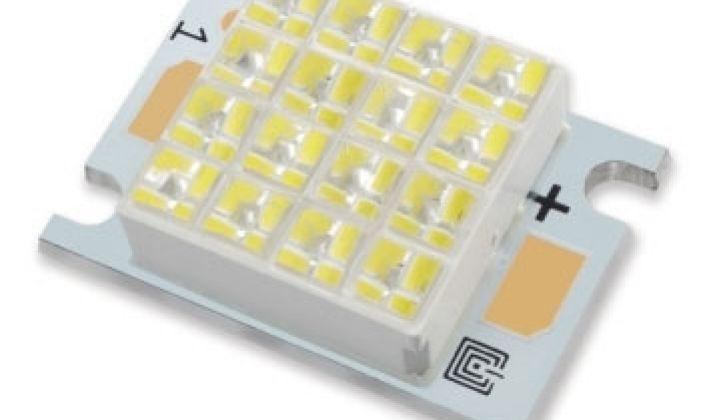Think of this as the waffle iron for modern lighting.
Illumitex, a startup out of Austin, Texas, has devised an LED bulb that it claims will both cut the cost and improve the quantity and quality of light coming from solid state lamps and ceiling fixtures.
The trick is that tiny grid you can see in the video at the end of the flashlight. The Illumitex LED package contains individual reflector units -- essentially small, cubical cavities open on one side with shiny surfaces -- for each LED in an array. When the LEDs emit light, the reflecting units direct the light straight ahead. Thus, a four-by-four grid of LEDs produces a solid, square beam made up of 16 smaller square beams of light.
Most light fixtures and bulbs direct light out in a circular pattern. So what's the big deal about this new design? Human civilization is mostly organized around straight lines: signs are square and most desks and paintings are rectangular. A square reflecting unit directs more of the light from the bulb onto the subject. You also don't get glare or fading and dimming at the edges because the light source is too close, or too far away, from the subject.
"The die itself is square. The fundamental laws of physics suggest that you should put the light out in a square beam," said CEO Matt Thomas.
When installed above a desk, Illumitex claims that 80 percent of the lumens created by its LED fixture will hit the area where a worker might need it. A bulb that lets light travel in a circular pattern might only put 31.5 percent of the light where it is needed. Overall, a 16-LED package from Illumitex will put out 500 lumens. That's less than the total lumens produced by a 60-watt bulb, which is usually close to 900. But the directional nature of the light makes up the difference, says Thomas. The 500-lumen array consumes 6.5 watts.
Think of a row of light bulbs above a sign. With conventional bulbs, you get scalloping (i.e., the light/shadow line above the sign undulates up and down in a scallop pattern). Illumitex can direct all of the light from its fixtures onto the sign.
Illumitex will also be cheaper than other LEDs in volume because the unusual package reduces the number of components required to build a lamp. Most LED makers put their LEDs under a phosphor-coated lens. A separate optical component, essentially, a reflective cone, is put on top of that to direct the light out. All of the reflective components and phosphors needed are contained in the package.
Additionally, because this design can direct more light to the area where it is needed, fewer LED bulbs may be necessary. The company claims it could be able to cut the bill of materials cost for a typical light fixture by 20 percent or more. In the future, you could just have a strip of these attached to the ceiling -- goodbye light fixtures, hello uncluttered ceiling. Other LED lamps will be small, too -- see the Helieon from Bridgelux -- but Illumitex potentially may take up even less real estate on your ceiling.
Take a look at the tests on the video. These were filmed in real-world, uncontrolled environments (read: our conference room). The cool white flashlight gives off a very solid beam. Some LED fixtures sometimes leave dim spots in the middle of the beam. And note the square shape of the beam. But the "soft white" bulb shows some green on the edge, so the color tone may need to be adjusted a bit.
The company does not make the LEDs used in its devices, Instead, it buys them from third parties. The secret sauce lies in the packaging that directs the light: many of the firm's engineers came from the optical communications industry. (The two physics principles behind the company are the conservation of radiance and the total internal reflection, Thomas said.)
NEA and DFJ Mercury have invested in the company and one of the advisors is Arno Penzias, the NEA partner who won a Nobel Prize for his role in confirming that the astronomical event known as the Big Bang actually occurred.
Although LED bulbs remain somewhat expensive and rare these days, the LED revolution that appears to be gaining steam likely will not be stopped. Lighting consumes 22 percent of the electricity in the U.S., and several nations -- Australia, Canada, the EU, the Philippines, and the U.S. -- have passed regulations that will force consumers and businesses to gravitate from incandescent bulbs to more energy-efficient lights like LEDs. Neon signs are already being retrofitted with LEDs, and several cities like Toronto and Anchorage have started to swap out traditional street lights with LEDs. (Plasma lights from companies like Topanga Technologies and Luxim will target street lights, too.)
Commercial buildings and homes will follow suit over the next few years. Besides saving power and reducing the number of times you have to swap bulbs, LEDs also let you add color effects. Osram, another lighting giant, is mixing muted color options into some of its LED fixtures.
Philips, General Electric, Osram, Lighting Sciences and others have all announced plans for LED bulbs that will put out the same amount of light as conventional 40- to 60-watt bulbs but consume far less power.



